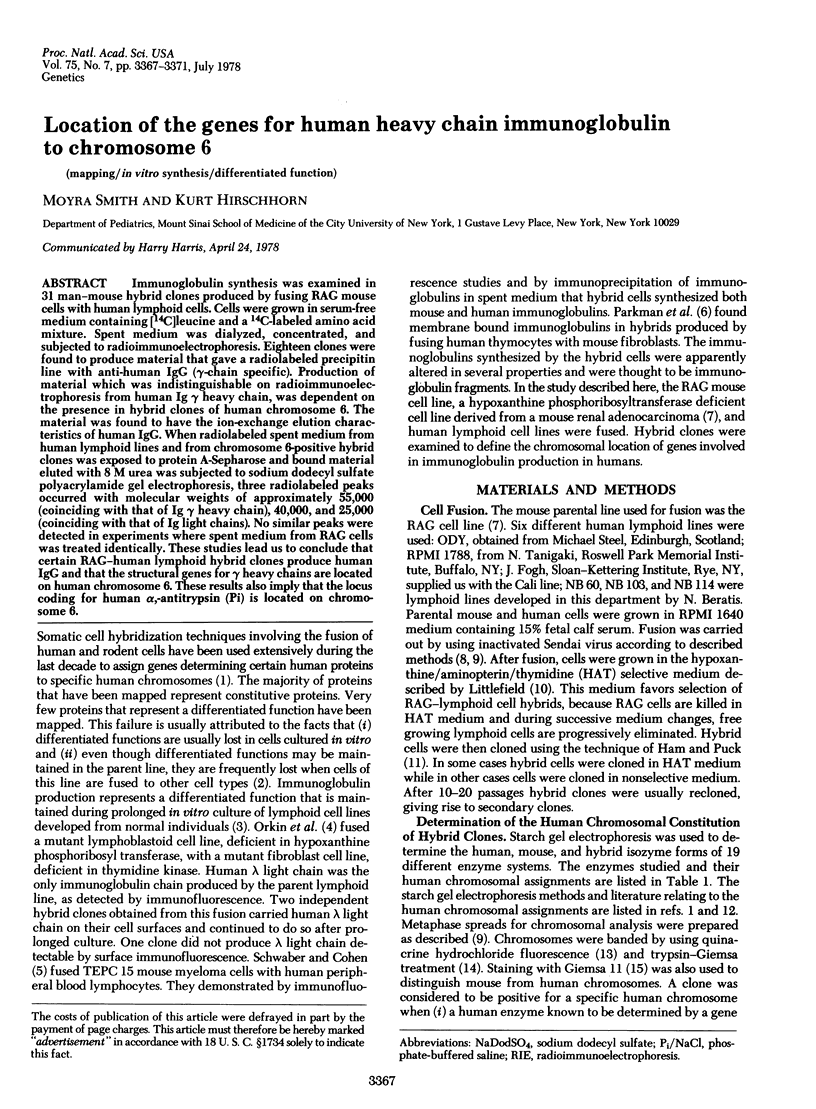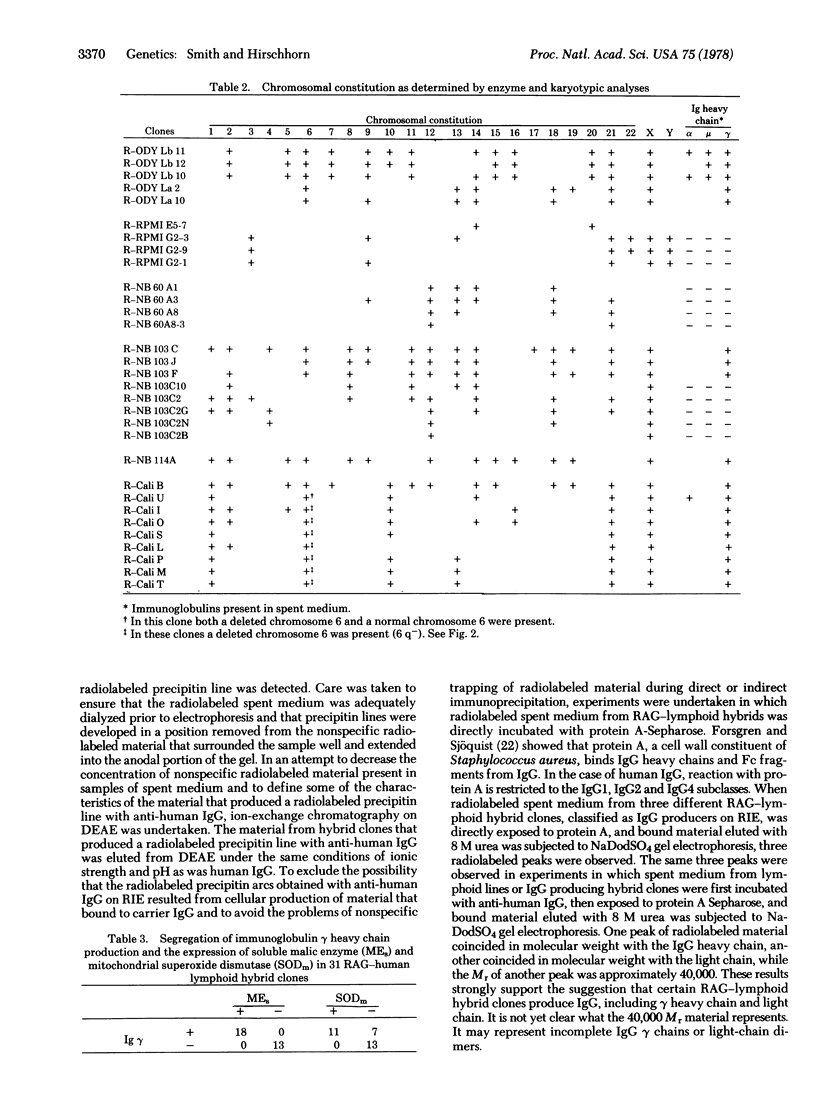Abstract
Immunoglobulin synthesis was examined in 31 man-mouse hybrid clones produced by fusing RAG mouse cells with human lymphoid cells. Cells were grown in serum-free medium containing [14C]leucine and a 14C-labeled amino acid mixture. Spent medium was dialyzed, concentrated, and subjected to radioimmunoelectrophoresis. Eighteen clones were found to produce material that gave a radiolabeled precipitin line with anti-human IgG (γ-chain specific). Production of material which was indistinguishable on radioimmunoelectrophoresis from human Ig γ heavy chain, was dependent on the presence in hybrid clones of human chromosome 6. The material was found to have the ion-exchange elution characteristics of human IgG. When radiolabeled spent medium from human lymphoid lines and from chromosome 6-positive hybrid clones was exposed to protein A-Sepharose and bound material eluted with 8 M urea was subjected to sodium dodecyl sulfate polyacrylamide gel electrophoresis, three radiolabeled peaks occurred with molecular weights of approximately 55,000 (coinciding with that of Ig γ heavy chain), 40,000 and 25,000 (coinciding with that of Ig light chains). No similar peaks were detected in experiments where spent medium from RAG cells was treated identically. These studies lead us to conclude that certain RAG-human lymphoid hybrid clones produce human IgG and that the structural genes for γ heavy chains are located on human chromosome 6. These results also imply that the locus coding for human α,-antitrypsin (Pi) is located on chromosome 6.
Keywords: mapping, in vitro synthesis, differentiated function
Full text
PDF




Images in this article
Selected References
These references are in PubMed. This may not be the complete list of references from this article.
- Breg W. R. Quinacrine fluorescence for identifying metaphase chromosomes, with special reference to photomicrography. Stain Technol. 1972 Mar;47(2):87–93. doi: 10.3109/10520297209116456. [DOI] [PubMed] [Google Scholar]
- Finegold I., Fahey J. L., Granger H. Synthesis of immunoglobulins by human cell lines in tissue culture. J Immunol. 1967 Nov;99(5):839–848. [PubMed] [Google Scholar]
- Forsgren A., Sjöquist J. "Protein A" from S. aureus. I. Pseudo-immune reaction with human gamma-globulin. J Immunol. 1966 Dec;97(6):822–827. [PubMed] [Google Scholar]
- Francke U., Pellegrino M. A. Assignment of the major histocompatibility complex to a region of the short arm of human chromosome 6. Proc Natl Acad Sci U S A. 1977 Mar;74(3):1147–1151. doi: 10.1073/pnas.74.3.1147. [DOI] [PMC free article] [PubMed] [Google Scholar]
- Friend K. K., Dorman B. P., Kucherlapati R. S., Ruddle F. H. Detection of interspecific translocations in mouse-human hybrids by alkaline Giemsa staining. Exp Cell Res. 1976 Apr;99(1):31–36. doi: 10.1016/0014-4827(76)90676-5. [DOI] [PubMed] [Google Scholar]
- Gedde-Dahl T., Jr, Fagerhol M. K., Cook P. J., Noades J. Autosomal linkage between the Gm and Pi loci in man. Ann Hum Genet. 1972 Apr;35(4):393–399. [PubMed] [Google Scholar]
- HAM R. G., PUCK T. T. A regulated incubator controlling CO2 concentration, humidity and temperature for use in animal cell culture. Proc Soc Exp Biol Med. 1962 Oct;111:67–71. doi: 10.3181/00379727-111-27707. [DOI] [PubMed] [Google Scholar]
- HARRIS H., WATKINS J. F. HYBRID CELLS DERIVED FROM MOUSE AND MAN: ARTIFICIAL HETEROKARYONS OF MAMMALIAN CELLS FROM DIFFERENT SPECIES. Nature. 1965 Feb 13;205:640–646. doi: 10.1038/205640a0. [DOI] [PubMed] [Google Scholar]
- Klebe R. J., Chen T., Ruddle F. H. Controlled production of proliferating somatic cell hybrids. J Cell Biol. 1970 Apr;45(1):74–82. doi: 10.1083/jcb.45.1.74. [DOI] [PMC free article] [PubMed] [Google Scholar]
- Littlefield J. W. The use of drug-resistant markers to study the hybridization of mouse fibroblasts. Exp Cell Res. 1966 Jan;41(1):190–196. doi: 10.1016/0014-4827(66)90558-1. [DOI] [PubMed] [Google Scholar]
- Litwin S. D., Hütteroth T. H., Lin P. K., Kennard J., Cleve H. Immunoglobulin expression of cells from human lymphoblastoid lines. II. Interrelationship among surface, cellular, and secreted immunoglobulins. J Immunol. 1974 Aug;113(2):668–672. [PubMed] [Google Scholar]
- McKusick V. A., Ruddle F. H. The status of the gene map of the human chromosomes. Science. 1977 Apr 22;196(4288):390–405. doi: 10.1126/science.850784. [DOI] [PubMed] [Google Scholar]
- Moseley J. M., Marchalonis J. J., Harris A. W., Pye J. Molecular properties of T lymphoma immunoglobulin. I. Serological and general physicochemical properties. J Immunogenet. 1977 Aug;4(4):233–248. doi: 10.1111/j.1744-313x.1977.tb00906.x. [DOI] [PubMed] [Google Scholar]
- Orkin S. H., Buchanan P. D., Yount W. J., Reisner H., Littlefield J. W. Lambda-chain production in human lymphoblast-mouse fibroblast hybrids. Proc Natl Acad Sci U S A. 1973 Aug;70(8):2401–2405. doi: 10.1073/pnas.70.8.2401. [DOI] [PMC free article] [PubMed] [Google Scholar]
- Ruddle F. H. Linkage analysis using somatic cell hybrids. Adv Hum Genet. 1972;30:173–235. doi: 10.1007/978-1-4757-4429-3_4. [DOI] [PubMed] [Google Scholar]
- Schwaber J., Cohen E. P. Pattern of immunoglobulin synthesis and assembly in a human-mouse somatic cell hybrid clone. Proc Natl Acad Sci U S A. 1974 Jun;71(6):2203–2207. doi: 10.1073/pnas.71.6.2203. [DOI] [PMC free article] [PubMed] [Google Scholar]
- Seabright M. A rapid banding technique for human chromosomes. Lancet. 1971 Oct 30;2(7731):971–972. doi: 10.1016/s0140-6736(71)90287-x. [DOI] [PubMed] [Google Scholar]
- Smith M., Hirschhorn K. Immunoglobulin production by human-mouse somatic cell hybrids. Trans Assoc Am Physicians. 1977;90:281–285. [PubMed] [Google Scholar]
- Weber K., Osborn M. The reliability of molecular weight determinations by dodecyl sulfate-polyacrylamide gel electrophoresis. J Biol Chem. 1969 Aug 25;244(16):4406–4412. [PubMed] [Google Scholar]
- Weitkamp L. R., May A. G., Johnston E. The linkage relationships of HL-A with other genetic marker systems. Hum Hered. 1975;25(5):337–345. doi: 10.1159/000152744. [DOI] [PubMed] [Google Scholar]




